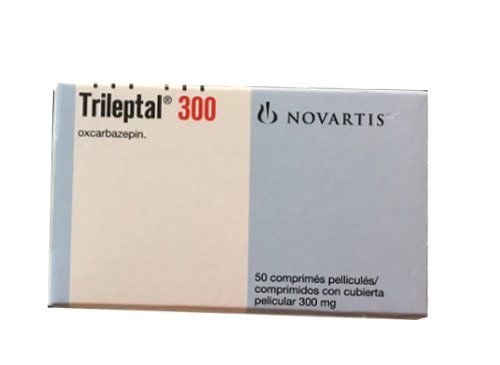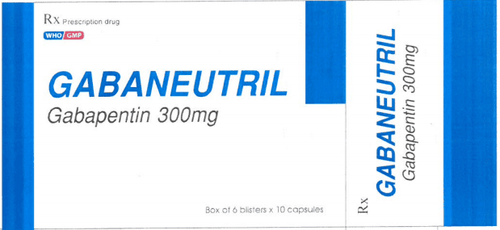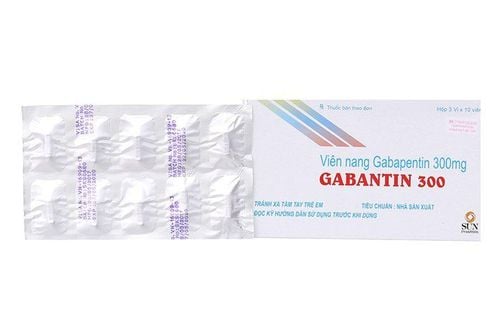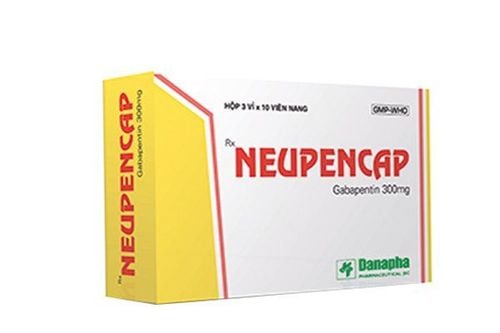This is an automatically translated article.
Duogab is a drug used in the treatment of epilepsy and to relieve neuropathic pain, with the main active ingredient being Gabapentin. The following article provides you with some information about the indications and notes when using Duogab.
1. Uses of Duogab
Duogab contains the main active ingredient, Gabapentin, which is made in the form of capsules with the strength of 100mg, 300mg and 400mg.
Gabapentin is an antiepileptic and neuropathic pain medication, the mechanism of which is currently unknown. In experimental animals, Gabapentin was effective against extremity spasticity after electric shock and inhibited convulsions caused by pentylenetetrazol. The chemical structure of Gabapentin is similar to that of the neurotransmitter gamma-aminobutyric acid (GABA), however, the drug does not act directly on GABA receptors, and does not alter its structure, release, metabolism, and metabolism. GABA absorption. The high-affinity gabapentin binding sites are localized in the brain, which corresponds to the presence of a characteristic voltage-dependent calcium channel with the alpha-2-delta-1 subunit. This calcium channel is located in the presynaptic region and can regulate the release of excitatory neurotransmitters that promote convulsions and pain.
2. Indications and contraindications of Duogab
2.1.Indications The use of Duogab is indicated in the following cases:
Monotherapy or adjuvant treatment in partial seizures, with or without recurrent generalized seizures. Treatment of neuropathic pain such as neuralgia in diabetes, inflammation of the peripheral nerves after shingles. 2.2.Contraindications Patients with hypersensitivity reactions to Gabapentin or any component of the drug.
3. How to take Duogab
Duogab is taken orally, the time of taking the drug does not depend on the meal.
Antiepileptic dosage:
Adults and children 12 years of age and older. As monotherapy or adjunctive therapy for partial seizures, with or without generalized seizures.
First day: 300mg x 1 time/day. Day 2: 300mg/time x 2 times/day. Day 3: 300mg/time x 3 times/day. The dose can then be increased in increments of 300 mg (in 3 divided doses) every 2-3 days, until an effective therapeutic dose is reached according to the patient's response. Usual dose response is 900 - 3600 mg/day; Maximum dose 4800mg/day. Divide the total daily dose into 3 times and the maximum interval between each dosing should not exceed 12 hours.
Patients with impaired renal function and on hemodialysis require appropriate dose adjustment according to creatinine clearance. The recommended dose of Gabapentin is as follows:
| Độ thanh thải creatinin (ml/phút) | Liều dùng hằng ngày |
| 50 - 79 | 600 - 1800mg/ngày, chia 3 lần/ngày |
| 30 - 49 | 300 - 900mg/ngày, chia 3 lần/ngày |
| 15 - 29 | 300 - 600mg/ngày, chia 3 lần/ngày, uống cách nhật |
| < 15 | 300mg/ngày, chia 3 lần, uống cách nhật |
| Thẩm phân máu | 200 - 300mg * |
The first loading dose for patients taking Gabapentin is 300 - 400 mg, then 200 - 300 mg after every 4 hours of hemodialysis. For days without hemodialysis, do not use Gabapentin.
Children 12 years and under: Used in the adjuvant treatment of partial seizures with or without generalized seizures.
Children 2 - under 6 years old: First day: 10mg/kg x 1 time/day. Second day: 10mg/kg x 2 times/day. The third day: 10mg/kg x 3 times/day. The dose is gradually increased depending on the response of each patient, the usual dose is 30 - 70 mg/kg/day, divided into 3 times/day. Children 6 - 12 years old: First day: 10mg/kg (maximum 300mg) x 1 time/day. Second day: 10mg/kg (maximum 300mg) x 2 times/day. Third day: 10mg/kg (maximum 300mg) x 3 times/day. Usual dose response: 25-35mg/kg/day in 3 divided doses/day. The maintenance dose is 900mg/day for children weighing 26-36kg and 1200mg/day for children weighing 37-50kg, the total daily dose is divided into 3 times. Maximum dose: 70mg/kg/day, divided into 3 times/day. Some children cannot tolerate daily increments, it may be more appropriate to extend the interval of increments (up to weeks). There are no evaluations regarding the use of Gabapentin in children under 12 years of age with renal impairment.
Treatment of neuropathic pain: Adults: The first day: 300mg x 1 time/day. Second day: 300mg/time x 2 times/day. The third day: 300mg/time x 3 times/day. Or the first day: 300mg/time x 3 times.
After that, the dose can be increased gradually by about 300mg (divided into 3 times/day), 1 time every 2-3 days, depending on the response of each patient, until the effective therapeutic dose is reached, the maximum dose maximum 3600mg/day.
4. Some notes when using Duogab
Precautions for the use of Duogab are as follows:
Caution should be exercised in all patients undergoing or initiating treatment with any anticonvulsant for any indication, requiring close monitoring because depression or worsening of depression may occur, suicidal thoughts or any unusual changes in mood may occur. Patients should not change their treatment regimen without consulting their doctor. Gabapentin should not be stopped abruptly, as this may increase seizures (status epilepticus). Discontinuation of gabapentin or addition of another anticonvulsant to the current regimen should be done gradually over at least 1 week. Gabapentin should be used with caution in patients with a history of psychosis, impaired renal function or on hemodialysis, or in drivers of vehicles or machines. Pregnancy: Gabapentin is teratogenic in rodents. Studies in pregnant women have not shown a similar effect. However, Gabapentin should only be used in pregnant women when absolutely necessary, carefully weighing the benefits to the mother and the risks to the fetus. Lactation: Gabapentin is excreted in human milk. Gabapentin should only be used by a nursing woman when clearly needed and carefully weighed the benefits and risks before taking it.
5. Undesirable effects when using Duogab
Gabapentin is generally well tolerated. Adverse effects were usually mild or moderate and subsided within 2 weeks with continued treatment. Some of the side effects that may be encountered when patients use Duogab are as follows:
Nervousness: fatigue, dizziness, loss of coordination, nystagmus, edema, drowsiness, memory loss. Memory loss, aphasia, headache, depression, irritability or mood swings, paralysis, decreased or lost libido. Digestive: dyspepsia, dry mouth, abdominal pain, diarrhea, constipation, taste disturbance. Cardiovascular: Peripheral angioedema, hypotension, angina, palpitations. Eyes: double vision, decreased vision, itchy eyes, lacrimation, iritis, retinopathy. Musculoskeletal: myalgia, arthralgia, osteoporosis, back pain. Skin: rash, skin rash. Blood: leukopenia. Other: impotence, viral infection, Stevens-Johnson syndrome.
6. Drug interactions
Gabapentin does not change the pharmacokinetics of commonly used antiepileptic drugs such as Carbamazepine, Valproic Acid, Phenobarbital, Phenytoin, Diazepam when used concurrently. Aluminum and magnesium-containing antacids: Concomitant administration of Gabapentin reduces the bioavailability of Gabapentin by about 20% by affecting drug absorption. Take Duogab at least 2 hours after the antacid. Morphine may decrease the clearance of gabapentin, so when these two drugs are administered concurrently, CNS depression should be controlled and the dose adjusted. Cimetidine: reduces the renal clearance of gabapentin. Duogab is a drug used in the treatment of epilepsy and neuropathic pain, with the main active ingredient being Gabapentin. To ensure the effectiveness of treatment and avoid unwanted side effects, patients need to strictly follow the instructions of the doctor, professional pharmacist.
Follow Vinmec International General Hospital website to get more health, nutrition and beauty information to protect the health of yourself and your loved ones in your family.
Please dial HOTLINE for more information or register for an appointment HERE. Download MyVinmec app to make appointments faster and to manage your bookings easily.













